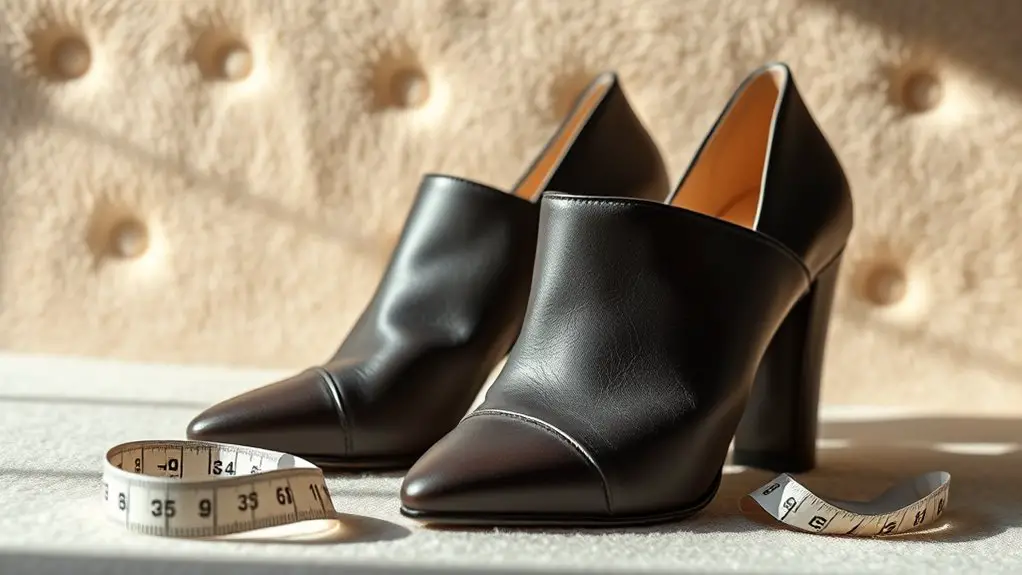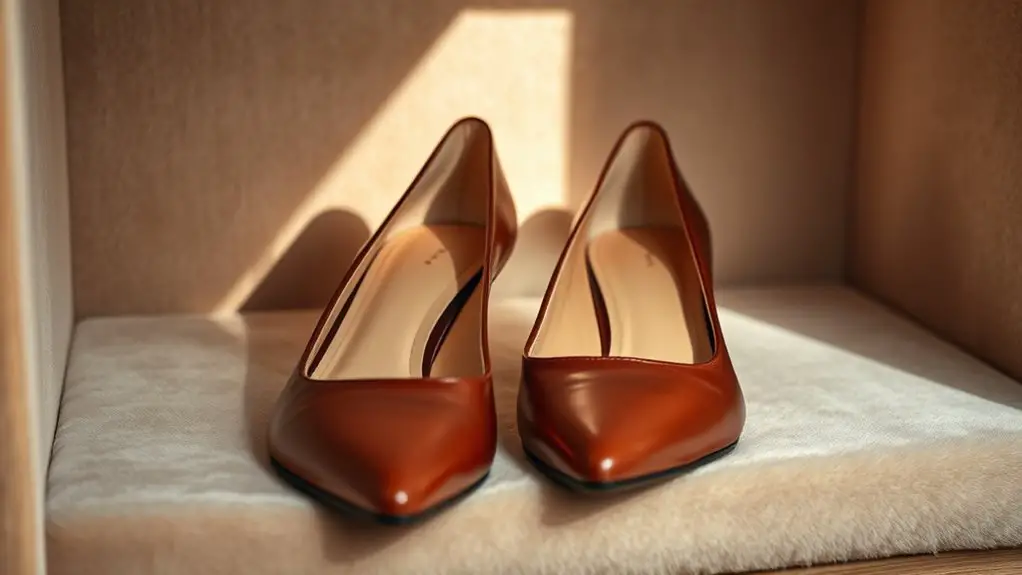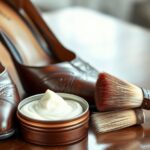To prevent creases in soft leather heels, start by choosing the right size and fit. A snug fit minimizes discomfort and bending. Invest in high-quality leather, like full-grain, to enhance durability. Rotate your shoes regularly to allow the leather to recover its shape. Use shoe trees for support and proper maintenance. Finally, store them upright in a cool, dry area and apply a good conditioner and protectant. There’s more valuable insight ahead to help you keep your heels looking pristine.
Choose the Right Size and Fit

Choosing the right size and fit is essential when it comes to preventing creases in soft leather heels. Proper heel sizing guarantees that your shoes conform to the natural shape of your feet, reducing the likelihood of excessive bending and creasing. When trying on heels, pay attention to how they feel; you shouldn’t experience pinching or discomfort. If you find a pair that’s almost perfect but slightly off, consider making fit adjustments. Adding insoles or using heel grips can improve snugness without sacrificing comfort.
Additionally, verify there’s a small amount of space between your toes and the shoe’s end—this will allow for natural movement as you walk. Remember, a well-fitted shoe not only enhances your style but also prolongs the life of the leather, keeping it crease-free. Prioritize finding a size that allows your feet to breathe, and you’ll enjoy your heels for much longer.
Invest in Quality Leather
When you invest in quality leather, you’re choosing materials that enhance the durability and appearance of your heels. Look for premium leather that not only resists creasing but also showcases excellent craftsmanship details, ensuring a stylish finish. Prioritizing comfort and fit is equally important, as the right pair will maintain its shape and support your feet effectively.
Choose Premium Materials
Investing in quality leather is essential if you want to maintain the pristine appearance of your soft leather heels. Choosing premium leather types, such as full-grain or top-grain leather, guarantees superior material durability. These leathers are not only more resistant to creasing, but they also age beautifully, developing a unique patina over time. When selecting your heels, look for leather that feels supple yet robust, indicating it can withstand daily wear. Avoid cheaper, synthetic options that may lack the breathability and resilience of quality leather. By prioritizing premium materials, you’re not just making a purchase; you’re investing in a long-lasting wardrobe staple that keeps your heels looking fresh and stylish for years to come.
Check Craftsmanship Details
While the type of leather is essential, the craftsmanship of your soft leather heels plays an equally significant role in preventing creases. When investing in quality, pay close attention to stitch quality and sole durability. High-quality stitching guarantees that the leather maintains its shape, reducing the likelihood of creasing over time. Additionally, durable soles provide stability and support, which can contribute to the overall longevity of your heels.
| Feature | Importance | Signs of Quality |
|---|---|---|
| Stitch Quality | Prevents creasing | Tight, even stitches |
| Sole Durability | Enhances longevity | Thick, resilient material |
| Leather Finish | Affects appearance and care | Smooth, even texture |
Prioritize Comfort and Fit
Quality craftsmanship is only one piece of the puzzle when it comes to soft leather heels; comfort and fit are equally important. When selecting your heels, consider your foot anatomy to guarantee the design accommodates your unique shape. A well-fitted shoe not only enhances comfort levels but also minimizes the risk of creases developing over time. Look for features like cushioned insoles and arch support to provide stability and reduce pressure on sensitive areas of your feet. Remember, investing in quality leather is vital; it molds to your foot, creating a personalized fit. Prioritizing comfort guarantees you can wear your heels confidently, without compromising on style or risking premature wear and creasing.
Rotate Your Shoes Regularly
Rotating your shoes regularly is essential for prolonging their lifespan and preventing unsightly creases. By alternating your footwear, you give the leather time to recover its shape, which can greatly reduce wear and tear. Establishing an ideal rotation schedule and utilizing proper shoe storage techniques will enhance this practice even further.
Benefits of Rotation
How often do you think about giving your shoes a break? Regularly rotating your shoes can greatly enhance shoe longevity and provide style versatility. By allowing each pair to rest, you reduce the risk of creases and maintain their shape.
| Benefit | Explanation | Impact on Shoes |
|---|---|---|
| Enhanced Longevity | Less wear and tear on materials | Longer lifespan of shoes |
| Improved Comfort | Allows materials to recover | Better fit and comfort |
| Style Versatility | Mix and match different styles | Fresh looks for various occasions |
Incorporating a rotation strategy not only keeps your footwear in top condition but also adds freshness to your outfits. So, next time you choose your shoes, consider giving others a turn!
Ideal Rotation Schedule
To maximize the benefits of rotation, establishing an ideal schedule for your footwear is key. By rotating your soft leather heels regularly, you can prolong their lifespan and maintain their shape. Aim for an ideal frequency of at least three pairs in your weekly rotation. This helps distribute wear evenly and reduces the likelihood of creasing.
Consider these tips for effective shoe rotation:
- Alternate between different styles to prevent fatigue.
- Allow each pair to rest for 24 hours after wear.
- Inspect shoes regularly for signs of wear.
- Clean and condition them as part of your routine.
- Keep track of which pairs you wear most often.
Following this schedule will guarantee your soft leather heels remain crease-free and stylish.
Shoe Storage Tips
Proper shoe storage plays an essential role in maintaining the integrity of your soft leather heels and preventing creases. One effective strategy is rotating your shoes regularly. This practice not only aids in shoe organization but also allows each pair to rest, reducing pressure on the leather. Guarantee your storage environment is equipped with climate control to avoid humidity and temperature fluctuations, which can damage your heels.
| Storage Method | Benefits | Tips |
|---|---|---|
| Shoe Boxes | Protects from dust and moisture | Use silica gel packs |
| Shoe Trees | Maintains shape | Choose cedar for odor control |
| Shelves | Easy access | Keep away from direct sunlight |
| Dust Bags | Prevents scratches | Use breathable fabric |
| Boot Hangers | Saves space | Guarantee they’re sturdy |
Use Shoe Trees for Support
Investing in quality shoe trees can make a significant difference in maintaining the shape and integrity of your soft leather heels. Shoe trees come in various types, including wooden, plastic, and metal options, each offering unique benefits to your footwear. By using shoe trees regularly, you can prevent creasing and extend the lifespan of your heels.
Here are some shoe tree benefits you’ll appreciate:
- Helps retain the original shape of the shoe
- Absorbs moisture to prevent odor and mildew
- Reduces creasing and cracking in soft leather
- Allows for better airflow, promoting freshness
- Assists in maintaining the shoe’s overall structure
Incorporating shoe trees into your routine not only enhances the look of your soft leather heels but also protects your investment, ensuring they remain stylish and comfortable for years to come.
Store Properly to Maintain Shape

While you might think that simply placing your soft leather heels on a shelf is enough, the way you store them plays a essential role in maintaining their shape. Proper shelf organization is necessary; consider keeping your heels upright and spaced apart to prevent them from rubbing against each other. Using boxes or dust bags can help protect them from dust while maintaining airflow.
Humidity control is another important factor. Leather is sensitive to moisture, so store your shoes in a cool, dry place. Using silica gel packets in your storage area can absorb excess humidity, helping to prevent warping and creasing. Avoid storing your heels in damp basements or hot attics, as these environments can damage the leather over time. By paying attention to how you organize and control the conditions of your storage space, you’ll greatly extend the life of your soft leather heels.
Apply Leather Conditioner and Protectant
Even with careful storage, soft leather heels can benefit from regular maintenance to keep them looking their best. Applying a quality leather conditioner and protectant is essential for effective leather care. This process not only nourishes the leather but also helps prevent creasing by maintaining its suppleness.
Regular maintenance with a quality leather conditioner is key to keeping soft leather heels nourished and crease-free.
Here are some useful conditioning techniques to follow:
- Choose the Right Product: Select a conditioner designed specifically for soft leather.
- Clean First: Wipe your heels with a damp cloth to remove dust and dirt.
- Apply Sparingly: Use a soft cloth to apply the conditioner evenly; too much can lead to a sticky residue.
- Allow to Absorb: Let the conditioner soak in for a few minutes before buffing.
- Protect Regularly: Use a protectant spray to guard against moisture and stains.
Frequently Asked Questions
Can I Use a Hairdryer to Remove Creases in Leather Heels?
Using a hairdryer can be effective for removing creases in leather, but you must be cautious. Keep it at a distance to avoid damaging the material. Always prioritize proper leather care for long-lasting results.
How Often Should I Apply Leather Conditioner?
You should apply leather conditioner every three to six months for ideal leather care. This conditioning frequency helps maintain softness and prevents drying, ensuring your leather items remain in great condition for years to come.
What Type of Shoe Trees Are Best for Soft Leather?
When choosing shoe trees for soft leather, wooden shoe trees are ideal due to their moisture-absorbing properties. Adjustable shoe trees can also provide a customized fit, helping maintain shape and prevent creasing effectively over time.
Is It Safe to Wear Heels in Rainy Weather?
Wearing heels in rainy weather isn’t ideal. For safety, consider waterproofing sprays and rubber sole covers. These rainy weather precautions and heel protection tips can help keep your footwear in good condition and prevent slips.
Can Creased Leather Be Repaired or Restored?
Imagine a book’s spine, worn yet cherished. Creased leather can often be restored using leather restoration techniques, but it’s essential to combine these with crease prevention methods to maintain that beloved look and prolong its life.



